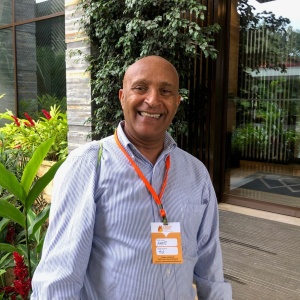Awdenegest Moges works in the department of Agricultural Engineering at Hawassa University, Ethiopia. He is the lead of the REDAA-funded project ‘Local-level land degradation assessment towards sustainable land management for improved livelihood in the Ethiopian Rift Valley (REDAA-SMILE)’ which focuses on community-based research and action for sustainable land use in the Ethiopian Rift Valley.
What is your REDAA-supported project trying to do?
We are trying to understand what land degradation means. As a scientist, I may say that the soil is gone, rainfall is causing the erosion and that’s what degradation means. But for farmers, that might not be the case.
For them it might mean a failure to grow their crop or a change in the leaf colour of the crop. We will assess land degradation within their context and at a larger scale as well.
Often these farmers may have less than one hectare – farming at a subsistence scale - which makes it difficult to look ahead when they need immediate benefits. But we want farmers to understand both what is causing degradation and what the solutions might be. And to be involved in a community-based conservation plan.
What will this conservation plan look like?
We aim to take land out of use and restore it through an exclosure (an area where there are no people or animal interferences). After two or three years, when it’s productive again, we will give it back with more grass, shrubs and trees. These will be done through facilitation from the local government but the community will lead the conservation.
Farmers need to see the benefits of excluding land so that it can be restored. So for sustainability, one way to do it is to empower young people and women to generate ideas that enable them to start businesses that are interdependent on regenerated land such as growing flowers for beekeeping or grass for livestock fattening programmes.
Your project has a strong gender angle. Can you describe what this looks like?
Women are one of the most vulnerable groups in society. Our intention is for women to come up with their own business ideas, which contribute to natural resource conservation. By doing so we not only promote gender equality but also leverage the innovative potential of women in addressing environmental challenges.
How do you work with women? What do you do to make sure that they feel confident to put ideas together?
For now, we are aiming to train about 120 community members (landless youth and women) from the community in business models and how businesses are developed. And after the training, we are going to provide funding for 80 of them from the REDAA grant.
The main point is that we are not going to tell them what to do; they will come up with their business ideas, and we will support them with the startup funding.
Are there any particular groups of women that you will be targeting for this initiative?
We are thinking of the household women, they could be widows or married, but their wealth status is going to be our focus. The poor and the poorest of the poor are our targets. Of course, this is what we have in mind, but it will be a joint decision with the community or the administration.
How do you make sure these household women can participate?
We are still working on the protocol but the idea is to find a suitable time for household women and bring them together in the nearest possible location to where they live. The training sessions will last half a day so they can be away from home for short period. And there will be two or three sessions, with assignments to discuss what they learned with their families or friends so that their ideas can develop.
What would you consider would be a sign that you've been successful?
This is an ambitious project! Devising a business model is one thing but we also want to see community involvement of different kinds: through school children, farmer training centres, the establishment of nurseries, the rehabilitation of highly degraded lands and the development of demonstration sites in model farmers. We need all these elements to engage the farmers that are living in that area.
We want the farmers and the communities to know the problem as well as the solution in their context, so that at the end of the day they are independent and able to manage and extend their activities in the future, upscaling to more members of the farming community.
On top of this, we want the Bureau of Agriculture – the government agricultural office in the smallest agricultural region - to take over the project outputs as part of their normal rural activities.
